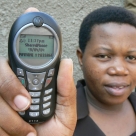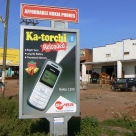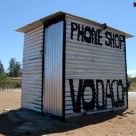Africa’s Grassroots Mobile Revolution: A Traveller’s Perspective
For the past twenty years I've been fortunate to live and work in a host of African countries, helping on a range of conservation and development projects. In 2003 my career switched focus to how mobile phones can help non-profit work on the continent, and since then mobile phones have sprung up almost everywhere. Today there are 700 million mobile subscribers in Africa, and their impact has, in many cases, been profound. In this essay, I write about a village in Uganda which I first visited in the 1990's. Returning ten years later I was witness to the impact mobile technology was having, and I talk about how the village had changed here.
It didn’t take us long to find it. After all, mobile phone masts aren’t that easy to hide, and Masindi is a tightly-knit, flat little west Ugandan town. After a few short minutes, driving past countless mobile phone dealerships, internet cafes and village phone operators, there it was. I was last in Masindi in 1998, not that long ago in the grand scheme of things, but a lifetime in the short history of the mobile phone. Back then this mast wasn’t there, and neither were any of the mobile phone shops, internet cafes and village phone operators. The only phone line out of town – if and when it was working – was courtesy of the local post office. Every couple of weeks we would drive here to collect our post from the Ugandan Wildlife Authority, post our letters, have a cold beer, buy a few ‘luxuries’ and occasionally attempt to phone home. No text messaging in those days.
Just as I had done ten years earlier, I sat in the Travellers Rest drinking coffee, watching Masindi life go by. Unfinished buildings littered the edge of town, a scene not unlike the last time I was there, except this time endless mobile advertising banners broke the view. In a bold marketing ploy the entire café was branded “Celtel red”, yet it was only just managing to compete with the “MTN yellow” across the road. People were busy in their shops, busy carrying goods, busy ferrying passengers on their bikes, and busy on their phones. The mobile revolution is here, there and everywhere for all to see. What has happened in Masindi is happening all over Africa, a continent which now boasts almost 300 million subscribers and a penetration rate fast approaching 30%.
And the beauty is that no-one expected it. Back in 2004 I co-authored one of the earlier reports on the potential of mobile phones in conservation and development work. Focussed mainly on Africa and funded by the Vodafone Group Foundation, we wrote it at a time when most people believed that rural Africans on a couple of dollars a day would never be able to afford a phone, let alone the credit to keep it going. Of course, four years ago mobile phones were expensive, but in many places the rampant growth of second hand markets made affordable handsets available for the first time. Nothing is thrown away here. At the same time, getting new phones into the hands of the masses was a key goal of the GSM Association’s “Emerging Market Handset Initiative”, announced back in 2005, an objective which continues to this day with the handset manufacturers themselves, many of whom are working hard to develop sub-$20 phones for this very unique “bottom of the pyramid” market.
Understanding consumers in emerging markets – many of whom have very different requirements of a phone – has spurned the development of handsets with multiple phone books, phones marketed as torches and even handsets with no screen. If you think that most of the innovation is going on in the West, take a moment to look at what’s happening in India and Africa. Even operators are getting in on the act, providing services such as “Call Me”, which allows Vodacom subscribers in South Africa to send up to five messages per day, free of charge, requesting a call back from the receiver. Services such as these have emerged in response to consumer behaviour, users who would have previously “flashed” the person they wished to speak to by ringing their phone once and hanging up. “Call Me” formalises the process, helps minimise network traffic through fewer prematurely disconnected calls, and allows operators to add value by differentiating their service from rival operators. A lot of the research, often the catalyst for these new devices and services, is increasingly lead by fellow anthropologists Jonathan Donner at Microsoft Research and Jan Chipchase at Nokia, both of whom spend considerable amounts of their time studying mobile phone use in the field and, in Jan’s case, working his way through a fair number of bicycles in the process.
When it comes to mobile innovation, the gap between developed and developing countries is not much of a gap at all. Mobile innovation in the West, largely technology-lead, sits in contrast to that in the developing world where combating the geographic, economic and cultural constraints of users is considered a more sensible way to go. This explains the emergence of the torch phone, for users who live in areas with little or no regular light, or multiple phone books for users who share their phones with family members. On the heavyweight side, a plethora of financial applications have hit the streets, with Safaricom’s m-Pesa service getting by far the biggest press to date. Regularly used by hundreds of thousands of Kenyans, you often hear it described as the “Kenyan Debit Card”, allowing users to transfer money through their mobile phones to help out family and friends, or to buy and sell goods and services across the airwaves. For the tens of millions of Kenyans without bank accounts, m-Pesa represents both a revolution and a revelation. It is now being rolled out in other countries, with Afghanistan next on the list.
Innovation is not always as official or formalised as this, however. People in developing countries are rarely simple, passive recipients of a technology, and rarely wait for outsiders to provide solutions to their problems. The entrepreneurial spirit is alive and well, evident by the masses of thriving small businesses you find on the street corners of every village, town and city. Last summer, in “A Review of The Postal and Telecommunications Sector: June 2006 to June 2007”, the Executive Director of the Uganda Communications Commission presented some quite incredible statistics. Official employment in Uganda’s ICT industry – dominated by telecommunications workers – sat at a little over 6,000. Informal, unofficial workers not directly employed, but who were making a living on the back of the industry, was estimated at a whopping 350,000. Amazing as it may be, Uganda is no exception. This is happening all over the African continent.
These ‘informal’ businesses come in all shapes and sizes, as do the kiosks many of them operate from, manufactured using anything from wood to metal sheeting, or made up of simple tables and plastic chairs. Mobile phone repair shops, often equipped with just a handful of basic (and frighteningly large!) tools, have sprung up to help owners squeeze the maximum life out of their devices, many being used in some of the harshest conditions imaginable. Mobile phones are attached to bikes (two and three wheelers), and even boats, and taken to where the business is. In Uganda these bikes, known locally as boda boda’s, are hooked up with spare batteries and desktop mobile devices to create what are affectionately known as “Bodafones”. I met the owner of one on Kampala Road last summer, and got talking to him through the universally accepted language of English Premier League football. He also accurately predicted the result of the Liverpool match later that day – I should have got his number.
In "Mobile Telephony: Leveraging Strengths and Opportunities for Socio- Economic Transformation in Nigeria", Christiana Charles-Iyoha sheds some fascinating light on the barriers to mobile ownership among Nigerian market traders. Erratic power supply, and difficulty charging, came top with a staggering 87%. Of course, Nigerians are not alone with this problem, and entrepreneurs are coming up with ingenious methods of meeting this crucial consumer need. Today, in some rural areas, users are able to charge their phones from a car battery which is taken to the nearest town, charged up and dragged back. In more urban areas with better mains supply, charging kiosks have sprung up allowing users to recharge their phones while they wait. Soon, with the continuing drop in the cost of solar chargers, many users will be able to do what I did last weekend down my local village green, and charge their phones using the most plentiful renewable energy source available – the sun (yes, we do occasionally get some in England). Interestingly, the total cost of this entire set up came to just over $40 - $22 for the ZTE handset (as being sold by MTN in Uganda), and $20 for the solar panel. Suddenly, with solar, there is light at the end of the charging tunnel.
Any discussion on mobile telephony, developing countries and economic opportunity would not be complete without a mention of Village Phone, Grameen’s pioneering work in Bangladesh which has recently taken root in Africa. A number of competing Village Phone schemes have since sprung up, providing business opportunities to mostly women, usually in rural areas, who borrow a small amount of money to purchase a phone. Members of the community, or passers-by, pay a small fee to make a call, or send a text message. Some of these schemes use desktop-style phones, which many owners prefer because of their ruggedness and the fact they are less likely to go walkabout. Culturally, bigger is also generally seen as better, a view somewhat at odds with how we feel about mobile devices in the Western world.
Other schemes use standard mobile phones, such as Nokia’s entry-level 1100 (for a while the best selling phone on the planet), while Motorola developed their own “pay phone” specifically for the job, allowing operators to enter the number of units to be used before handing the phone over to the caller. This helped ensure customers didn’t talk for longer than they’d paid for, and negated the earlier practice of operators having to rudely grab phones back with their clients in mid-sentence, or having to smack their hands down on the hang-up button of a desk phone before they’d had the chance to say goodbye.
In many places I’ve seen handsets used primarily as phone books, torches or even once as a method of keeping track of bad debts, but despite some ingenious offline applications mobiles are not much use as a communications device without a signal. On the whole, operators are doing what they can, but with geographically disbursed populations, often with little disposable income, it’s sometimes difficult to make a business case for increasing coverage to an area with a minimal, and scattered, population. But where networks do exist, operators in East Africa are blazing a trial, doing something unheard of in Europe and in many other parts of the world. We’re talking roaming, and we’re talking “one network”.
Celtel, MTN and Vodacom are just three of a growing band of African operators tearing down national boundaries to allow their customers seamless mobility as they travel from country-to-country. Advertising boards are scattered everywhere. "One SIM card. 6 countries" proclaims Celtel. "Travel with your Vodacom SIMcard and enjoy Vodacom tariff in Kenya and Uganda" boasts Vodacom. The speed of change in the mobile industry – more so it seems in developing countries – continues unabated. Again, the telecommunications gap between the so-called developed and developing countries looks a little blurred. Travelling across central Africa with a single SIM, on a single tariff, is a business person’s dream.
You may not see a Bodafone on your street anytime soon, but you may see a single European-wide network.
And if you do, just remember where it happened first...
Ken Banks, Founder of kiwanja.net and FrontlineSMS, devotes himself to the application of mobile technology for positive social and environmental change in the developing world. He has worked at the intersection of technology, anthropology, conservation and development for the past 20 years and, during that time, has lived and worked across the African continent. He is a Pop!Tech Fellow, a Tech Awards Laureate, an Ashoka Fellow and a National Geographic Emerging Explorer, and has been internationally recognised for his technology-based work.




